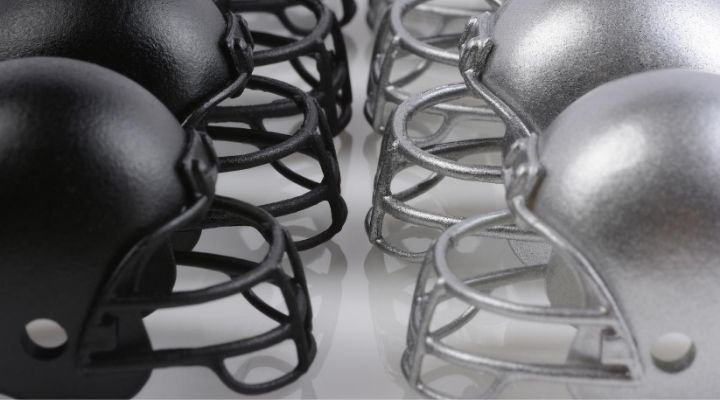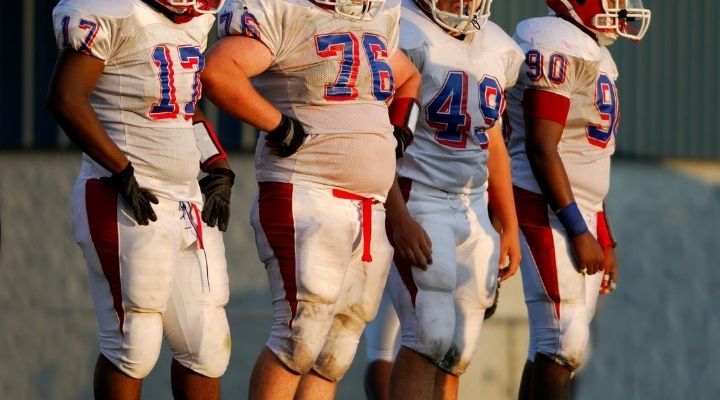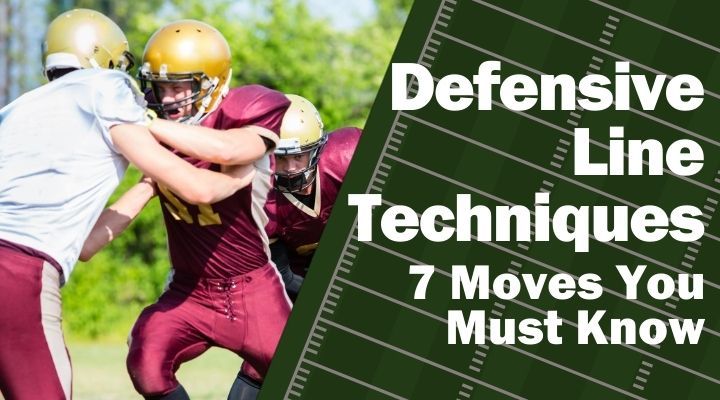Defensive line seems like one of the more straightforward positions on a football team.
They start the play at the line of scrimmage, and their job is to get into the backfield to disrupt the offense -- in whatever way they can.
Defensive linemen aren't necessarily asked to make a lot of tackles (though some do).
They’re not necessarily counted on to record a lot of sacks (though some do).
They’re hardly ever asked to drop in pass coverage (though some NFL teams employ this strategy now).
Their primary job is literally to just cause disruption.
But while their duties seem simple enough, how they’re successful in doing so is a little more complicated.
After all, they must constantly take on blocks with offensive linemen who have big bodies.
Defensive linemen have several techniques that they can use to combat the blocks from offensive linemen and still get into the backfield.
These are some tried-and-true moves they can use to break free from blocks and get by the offense.
Before we discuss the specific moves that they can use, though, let's take a look at the breakdown of the different defensive line techniques, as they're known -- where the players align themselves along the line of scrimmage and what types of players play each technique.

How Defensive Line Techniques Are Labeled
To make it uniform for defensive teams and coaches, uniform labels are given to each of the gaps and the positioning of defensive linemen along the line of scrimmage.
- Gaps between the center and offensive guards are called the A gap.
- Gaps between the offensive guards and offensive tackles are called the B gap.
- Gaps between the offensive tackle and tight ends are called the C gap.
The defensive line techniques are labeled based on the different positions along the offensive line.
They’re numbered based on where the defensive lineman would align himself with the offensive lineman opposite him.
The numbers are:
- 0: Heads up on the center
- 1: Over either shoulder of the center
- 2i: Over the inside shoulder of the guard (toward the center)
- 2: Heads up on either guard
- 3: Over the outside shoulder of the guard (toward the tackle)
- 4i: Over the inside shoulder of the tackle (toward the guard)
- 4: Heads up on either tackle
- 5: Over the outside shoulder of the tackle (toward the tight end)
- 7: Over the inside shoulder of the tight end (toward the tackle)
- 6: Heads up on the tight end
- 9: Over the outside shoulder of the tight end

What Types of Players Occupy Each Technique
Different types of defensive linemen will occupy each of these techniques.
Let's take a look at the types of players by technique:
0
These players are called nose tackles. They line up directly across from the center. They’re usually big-bodied players. They’re responsible for covering both A gaps. And they’re usually employed in a 3-4 defensive front.
1
These players are also called nose tackles but are generally employed in a 4-3 defensive front. They shade their alignment over one of the center's shoulders and are responsible for the A gap on the side of the field they're shading to. They’ll often take on double teams from centers and offensive guards.
3
These are defensive tackles in a 4-3 defensive front who are often pass-rushing specialists. They’ll line up over the guard in any of the positions listed above. Their job is to attack the B gap. This technique is designed to give the tackle a chance to take on a single offensive lineman.
4 or 5
These are defensive ends in a 3-4 defensive front. They line up across from the offensive tackle. They can be responsible for both the B and C gaps or just one gap, depending on the scheme. They often try to get into the backfield first and stop the run second.
6 or 7
This player will either be a defensive end in a 4-3 defensive front or an offensive linebacker in a 3-4 defensive front. It can either be used as a run-stuffing player on the outside of the line or a pass-rushing specialist as well.
9
This player will be the same as a 6 or 7 technique. The difference is that this player's primary job will be to rush the quarterback. Their job is to get into the backfield and cause disruption in the passing game.

The Moves Defensive Linemen Can Use
Where a defensive lineman positions himself along the line of scrimmage before the snap will in part determine what his primary responsibilities on that play will be.
That's the basis of the defensive scheme. The way that defensive linemen accomplish their duties is by using various moves.
Let's take a look at each of these moves and how players can use them.
a. Forearm Lift
As the lineman moves toward the line of scrimmage, he must bend the arm that’s closest to the offensive lineman at a 90-degree angle.
It should be bent at the elbow, and his fist should be clenched and placed in front of his chest. He’ll then use this arm to contact the offensive lineman in his numbers.
The idea is that this will straighten the offensive player, thereby neutralizing his move.
The free hand of the defensive lineman should be thrust at the near shoulder of the offensive lineman.
The heel of this hand should strike the lineman, while the defensive player keeps his shoulder squared at the line of scrimmage.
b. Submarine
This move looks exactly like it sounds.
The defensive player seeks to get by the offensive lineman by surging under the offensive lineman and/or between two blockers.
The key to being successful with this move is for the defensive lineman to stay low to the ground.
At the snap of the ball, he must remain low and burst forward so that he can get underneath the offensive lineman.
Many defenders who use this move will start the play in a four-point stance, with both hands on the ground to keep them lower.
c. Shoulder Charge
This move is used by defenders whose job is to occupy offensive linemen and clog up a gap.
A lot of times, this will be used by nose tackles because their job is often to simply occupy the center so that other defenders have an open gap to rush through.
The easiest way to understand this move is to think of it as the defender blocking the offensive lineman.
He’ll simply try to drive through the offensive player the same way the offensive player would drive through him.
He'd target the near shoulder of the offensive player to stop his offensive charge, then neutralize his movement and push him back.
He needs to keep his feet at a stable position so that he can absorb the initial impact and then be able to drive through the offensive player at the shoulder impact.
d. Rip Move
The rip move is one of the classic moves for a defensive lineman.
It’s meant to allow the defensive lineman to burst past the offensive lineman.
Because of this, it’s often used by players who are rushing the quarterback and trying to get into the backfield.
The defensive lineman will create a fist with his inside hand and try to get the hand inside the offensive lineman's armpit.
Then, using a ripping-up motion, he’ll lift the offensive lineman's arm up in the air, which will turn him and throw him off balance.
This will allow the defensive lineman to get into the backfield in all one forward motion.
e. Spin Move
This is another classic move for defensive linemen who are looking to get past an offensive lineman into the backfield.
It’s often used by defensive ends or outside linebackers who are rushing the quarterback.
The move starts with the defender driving the offensive lineman back by putting a lot of force and weight on one of his shoulders.
He'll need to keep separation from the offensive lineman, though, so that he isn't "gobbled up" by his body.
He'll then push off with his inside hand and spin his whole body either clockwise or counter-clockwise, depending on which side of the offensive lineman he wants to attack.
When executed properly, the defensive lineman will be able to blow by the offensive lineman and attack the backfield unimpeded.
f. Jump Over
This is a defensive line move that should only be used in certain situations and only by certain players.
The risk of using this move is that it takes the defensive player off his feet and, therefore, commits him to that one move.
It's very hard to adjust if it doesn't work.
The defender will be looking to get into the backfield and beyond the offensive lineman by leaping over him.
It’ll seek to take advantage of an offensive lineman who’s either shorter or who tries to stay real low and attack a defensive lineman's legs.
This move takes great timing, athleticism, and strength.
The defender must be able to leap over the offensive lineman, land on his feet, keep his balance, and then attack quarterbacks going forward.
g. Shoulder Fake Charge
This move is used by a lot of defenders who are taking on two offensive linemen on a particular play.
It's meant to try to avoid contact as much as possible when dealing with this double team to get into the backfield.
The goal is to make the offensive linemen think you’re going to take on their blocks directly, only to fake them out and dip under.
He'll start the play normally, as if he's going to drive through his opponents, only to dip under the shoulder of the offensive linemen at the last minute.

Conclusion
While all defensive linemen have fairly simple roles and responsibilities, they have several different alignments and many different moves that they’ll use to try to get that job done.
The moves listed above can be taught to any position on the defensive line -- no matter the role they fill or what defensive scheme is in use.
By learning these defensive line techniques, you'll be better prepared to attack the difficult challenge of taking on big-bodied offensive linemen and creating separation to get in the backfield.
Ultimately, this will result in them doing their #1 job -- creating disruption at the line of scrimmage.

